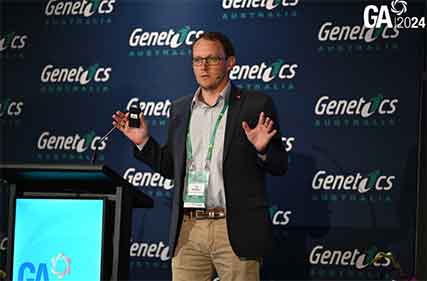
Associate Professor Dr Ky Pohler
Managing estrus intensity is a vital tool in reducing pregnancy loss and the Estrotect patch can help farmers to make the right choices. Associate Professor Dr Ky Pohler from Texas A&M University told the Genetics Australia 2024 conference that assisted reproductive tools increase genetic gains.
“Reproductive technology has been key in changing the way agriculture works around the world,” he said.
Ky highlighted the importance of estrus intensity in not only getting cows pregnant but in maintaining those pregnancies. “We should be proud of the pregnancy rates we have. We need to concentrate on maintaining the pregnancies we have, rather than solely thinking about how we get more pregnancies,” he said.
The modern US cow has about 30 per cent loss in the first 28 days of gestation and 12-14 per cent loss from day 28 to day 60. In beef, there is a loss of about 7-9 per cent of pregnancies from day 30 to day 100 of gestation.
These losses are a huge focus of research at Texas A&M University. “Pregnancy loss is a major issue on farms but it’s not like overnight our cattle started to lose more pregnancies; we’re just doing a better job of detecting it,” Ky said. “We have decent fertility, but it makes sense to look at how we can better maintain those pregnancies. A cow losing pregnancies from day 30-60 costs more than a cow that never got pregnant.”
The Estrotect patch has been developed to better manage pregnancy loss, with a new breeding bullseye black dot in the middle used to score estrus levels of cows. Cows with higher scores have higher pregnancy rates and lower pregnancy loss.
“As estrus intensity increases, you have increased fertility and also decreased pregnancy loss,” Ky said. “With lower estrus levels cows still get pregnant, but have 12 per cent pregnancy loss compared to 4 per cent among those with high estrus levels.”
The new Estrotect patch is making management decisions easier behind the cow, with the patch being used to target sexed semen into higher performing cows.“As we increase estrus intensity, we increase the protein level which leads to a better pregnancy rate and less pregnancy loss,” Ky said.
“By getting cows with more activated patches with black dots rubbed off, you not only get an increase in fertility, you get an increase in maintaining that pregnancy to day 60 of gestation. That means a high probability to get to calving.” He added that new technologies should be kept simple to use so farmers can make the right clinical care decisions.
-Genetics Australia
